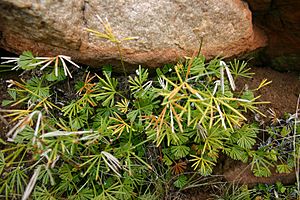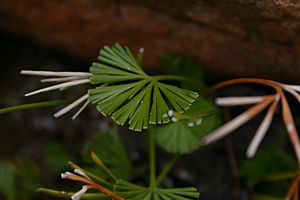Actiniopteris radiata facts for kids
Quick facts for kids Actiniopteris radiata |
|
|---|---|
 |
|
| Actiniopteris dimorpha | |
 |
|
| Actiniopteris dimorpha | |
| Scientific classification | |
| Genus: |
Actiniopteris
|
| Species: |
radiata
|
Actiniopteris radiata is a type of fern that grows in many parts of the world. Its name, Actiniopteris, means 'ray fern', which describes its unique shape. You can find this fern across Africa and nearby islands, Madagascar, the Arabian Peninsula, Iran, Afghanistan, Nepal, India, Sri Lanka, Myanmar, and Australia. It looks quite similar to another fern called Actiniopteris dimorpha.
Contents
Where This Fern Lives
This fern likes hot, dry places. It often grows at the bottom of rocks or in small cracks in them. Sometimes, it also grows in deep soil in shady spots. You can commonly find it in forests where trees lose their leaves, especially in areas that are always warm and don't get much rain. It grows at heights from 500 to 1300 meters above sea level.
What Actiniopteris radiata Looks Like
This fern has very special leaves, which are called fronds. These fronds grow from a stem that lies flat on the ground, known as a rhizome. Some of its fronds might look a bit different from others.
The main part of the fronds is shaped like a fan. They are usually 15 to 45 millimeters long. They spread out almost like a half-circle, about 180 degrees. The tip of each part of the fan has 2 to 5 small teeth.
Interesting Uses of the Fern
Scientists have studied Actiniopteris radiata to see what it can do. They found that liquids made from this fern can help with pain. These extracts also show activity against certain types of bacteria. For example, they can fight against Salmonella typhi, which causes food poisoning, and Staphylococcus aureus, which can cause skin infections. They also work against Escherichia coli, a common bacteria.
This fern also has other useful properties. It can help stop bleeding and fight against worms. It also has properties that protect cells from damage. The fern contains several natural chemicals, including hentriacontane, hentriacontanol, and β-sitosterol.
A Stamp of Recognition
In 1992, the country of Botswana honored this fern. They put a picture of Actiniopteris radiata on one of their postage stamps. The stamp was designed by an artist named Gillian Condy.
Synonyms
Synonyms are other scientific names that have been used for this fern in the past. They include:
- Acrostichum radiatum (J.König ex Sw.) Poir.
- Actiniopteris australis sensu Sim
- Asplenium radiatum J.König ex Sw.
- Pteris radiata (J.König ex Sw.) Bojer
Images for kids



